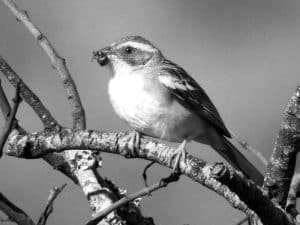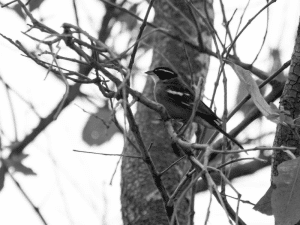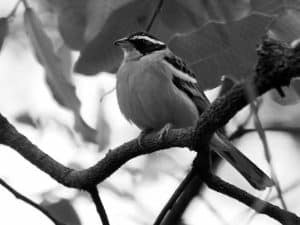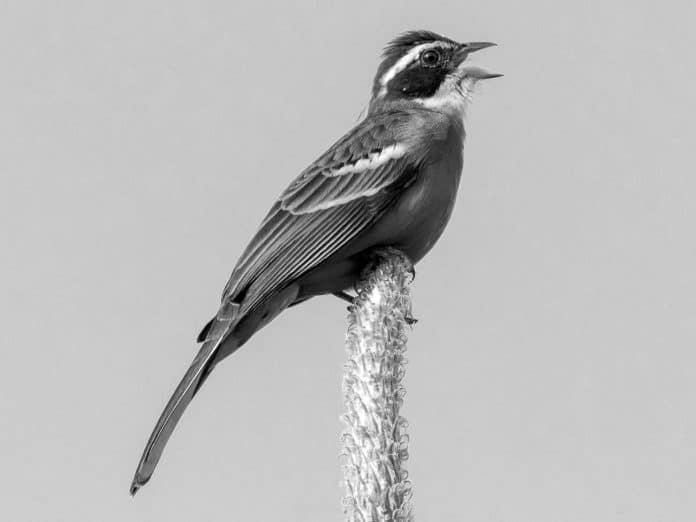Introduction to Cabanis’s Bunting
Tucked away in the lush landscapes of Tanzania lies a true gem for birdwatchers – the captivating Cabanis’s Bunting. This small, vibrant songbird is a delight to spot and observe, with its distinctive plumage and charming behavior. As you embark on your birdwatching adventure, the Cabanis’s Bunting in Tanzania is sure to captivate your senses and leave a lasting impression.

In this comprehensive guide, we’ll explore the enchanting world of the Cabanis’s Bunting, delving into its habitat, physical characteristics, and the best spots to catch a glimpse of this avian treasure. Whether you’re a seasoned birdwatcher or a curious nature enthusiast, this article will equip you with the knowledge and insights to make the most of your Tanzanian birdwatching experience.
Overview of Tanzania as a Birdwatching Destination
Tanzania is renowned as a premier destination for birdwatchers, offering a diverse array of avian species that can captivate the senses. With its vast and varied landscapes, from the iconic Serengeti plains to the lush rainforests and towering mountains, Tanzania is a true haven for bird lovers.
The country boasts an impressive avian diversity, with over 1,100 species recorded within its borders. This makes Tanzania one of the top birdwatching destinations in Africa, attracting enthusiasts from around the world who seek to catch a glimpse of the region’s unique and often elusive bird species.
Habitat and Distribution of Cabanis’s Bunting in Tanzania
The Cabanis’s Bunting (Emberiza cabanisi) is a resident species in Tanzania, found predominantly in the central and southern regions of the country. These charming birds thrive in a variety of habitats, including:
- Acacia Woodlands: The Cabanis’s Bunting is particularly well-adapted to the acacia-dominated woodlands that cover vast expanses of Tanzania’s landscape.
- Montane Forests: These birds can also be spotted in the lush, higher-altitude forests that dot the country’s mountainous regions.
- Grasslands and Scrublands: Cabanis’s Buntings are known to inhabit open grasslands and scrubby areas, often in close proximity to wooded habitats.
The distribution of Cabanis’s Buntings in Tanzania is widespread, with the species being found in various protected areas, national parks, and wildlife reserves throughout the central and southern parts of the country. This makes them an accessible and rewarding target for birdwatchers exploring the Tanzanian wilderness.
Physical Characteristics and Behavior of Cabanis’s Bunting
The Cabanis’s Bunting is a small, stocky bird with a distinctive appearance. Its most striking feature is the vibrant chestnut-colored head and nape, which contrasts beautifully with the bird’s gray back and wings. The underparts are a soft, pale gray, and the bird’s beak is short and conical, adapted for its seed-based diet.
In terms of behavior, Cabanis’s Buntings are typically found in small flocks or pairs, hopping and flitting among the branches of acacia trees or perching atop tall grasses. Their call is a pleasant, trilling song that can be heard echoing through the woodlands, adding to the overall enchantment of the birdwatching experience.
These birds are known for their active and curious nature, often approaching birdwatchers with a sense of intrigue. This makes them an engaging and rewarding subject for observation, as you can witness their unique behaviors and interactions up close.
Tips for Birdwatching Cabanis’s Bunting in Tanzania

To maximize your chances of spotting the elusive Cabanis’s Bunting during your Tanzanian birdwatching adventure, consider the following tips:
- Timing: The best time to observe Cabanis’s Buntings is during the early morning and late afternoon hours, when they are most active and vocal.
- Habitat Identification: Familiarize yourself with the preferred habitats of Cabanis’s Buntings, such as acacia woodlands, montane forests, and grasslands, and focus your search efforts in these areas.
- Patience and Stealth: Cabanis’s Buntings can be quite shy and easily startled. Approach them slowly and quietly, and be prepared to wait patiently for the birds to reveal themselves.
- Utilize Local Guides: Enlisting the services of experienced local birdwatching guides can greatly increase your chances of spotting Cabanis’s Buntings, as they have intimate knowledge of the birds’ behavior and preferred haunts.
- Bring the Right Gear: Equip yourself with a high-quality pair of binoculars, a camera with a telephoto lens, and a field guide to help you identify the Cabanis’s Bunting and other bird species you may encounter.
By following these tips and remaining vigilant, you’ll be well on your way to enjoying the enchanting sight of the Cabanis’s Bunting in its natural habitat.
Conservation Status and Threats Facing Cabanis’s Bunting
The Cabanis’s Bunting is currently classified as a species of Least Concern by the International Union for Conservation of Nature (IUCN). However, like many bird species, it faces a variety of threats that could potentially impact its long-term survival.
One of the primary threats to the Cabanis’s Bunting is habitat loss and degradation. As Tanzania’s landscapes undergo changes due to factors such as deforestation, agricultural expansion, and urbanization, the bird’s preferred acacia woodlands and montane forests are under increasing pressure. This can lead to the fragmentation and loss of suitable habitats, potentially affecting the species’ population and distribution.
Additionally, the Cabanis’s Bunting may be impacted by the illegal wildlife trade, as its vibrant plumage and melodic song make it a target for the pet trade. Increased awareness and enforcement of conservation measures are crucial to ensuring the protection of this enchanting species.
Other Bird Species to Look Out for While Birdwatching in Tanzania
While the Cabanis’s Bunting is undoubtedly the star of the show, Tanzania’s diverse avian landscape offers a wealth of other captivating bird species for birdwatchers to discover. Some of the notable species you may encounter during your Tanzanian birdwatching adventure include:
- Kilimanjaro Shrike: A striking bird of prey with a distinctive black-and-white plumage, often spotted soaring over the Serengeti plains.
- Lilac-breasted Roller: A vibrant, iridescent bird known for its acrobatic aerial displays and stunning coloration.
- Superb Starling: A dazzling, metallic-hued bird that thrives in a variety of habitats, from savannas to urban areas.
- Silvery-cheeked Hornbill: A large, impressive hornbill species with a distinctive casque atop its beak, found in the forested regions of Tanzania.
- Fischer’s Lovebird: A small, social parrot species that can be observed in lively flocks, often in close proximity to human settlements.
By keeping an eye out for these and other captivating bird species, you’ll be able to immerse yourself in Tanzania’s rich avian tapestry and enhance your overall birdwatching experience.
Recommended Birdwatching Spots in Tanzania for Seeing Cabanis’s Bunting

Tanzania offers a wealth of destinations that are prime for birdwatching and spotting the elusive Cabanis’s Bunting. Some of the top recommended spots include:
- Ruaha National Park: This expansive park in central Tanzania is home to a diverse array of habitats, including acacia woodlands that are ideal for Cabanis’s Bunting sightings.
- Mikumi National Park: Located in the eastern part of the country, Mikumi National Park boasts a variety of ecosystems, including grasslands and scrublands, making it a prime location for Cabanis’s Bunting observation.
- Udzungwa Mountains National Park: The lush, montane forests of this park in southern Tanzania are a prime habitat for the Cabanis’s Bunting and other highland bird species.
- Kitulo National Park: This stunning, high-altitude grassland and alpine meadow ecosystem in southwestern Tanzania is a hidden gem for birdwatchers, offering excellent opportunities to spot the Cabanis’s Bunting.
- Selous Game Reserve: As one of the largest protected areas in Africa, the Selous Game Reserve in southern Tanzania is a vast and diverse birdwatching destination, including prime Cabanis’s Bunting habitat.
By focusing your birdwatching efforts in these recommended areas, you’ll significantly increase your chances of encountering the captivating Cabanis’s Bunting during your Tanzanian adventure.
Planning Your Birdwatching Trip to Tanzania
Embarking on a birdwatching expedition to Tanzania requires careful planning and preparation to ensure a successful and enjoyable experience. Here are some key considerations to keep in mind:
- Timing: The best time to visit Tanzania for birdwatching is typically during the dry season, which runs from June to October. This is when migratory birds are present, and the vegetation is less dense, making it easier to spot resident species like the Cabanis’s Bunting.
- Accommodation: Research and book your accommodations in advance, ensuring they are located in close proximity to your desired birdwatching spots. Many lodges and camps in Tanzania cater specifically to birdwatchers, offering guided tours and specialized amenities.
- Transportation: Arrange for reliable transportation, either by renting a vehicle or booking a guided tour with a reputable operator. This will allow you to efficiently navigate the diverse landscapes and access the prime birdwatching locations.
- Packing: Equip yourself with the necessary gear, including binoculars, camera equipment, field guides, and appropriate clothing for the climate and terrain.
- Local Expertise: Consider hiring a knowledgeable local guide or joining a guided birdwatching tour to maximize your chances of spotting the Cabanis’s Bunting and other sought-after species.
By carefully planning your Tanzanian birdwatching adventure, you’ll be well-prepared to immerse yourself in the enchanting world of the Cabanis’s Bunting and the country’s diverse avian wonders.
Conclusion: The Allure of Cabanis’s Bunting in Tanzania
The Cabanis’s Bunting is a true gem of the Tanzanian birdwatching landscape, captivating the senses of nature enthusiasts and avid birders alike. Its vibrant plumage, melodic song, and engaging behavior make it a sought-after species for birdwatchers exploring the country’s diverse ecosystems.
As you embark on your Tanzanian birdwatching adventure, keep a keen eye out for the Cabanis’s Bunting, and let its enchanting presence transport you to a world of natural wonder. Whether you spot it perched atop an acacia tree, flitting through a montane forest, or foraging in a grassy meadow, the experience is sure to leave a lasting impression and fuel your passion for the incredible diversity of Tanzania’s avian life.

































